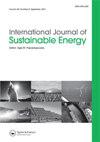地埋球墨铸铁供热管道的传热特性和隔热优化
IF 2.7
Q4 ENERGY & FUELS
引用次数: 0
摘要
摘要 本研究调查了球墨铸铁供热管道中的传热情况,并通过对不同技术的比较评估建立了一个数学模型。目的是准确描述埋地管道中的非稳态传热。通过考虑假设、方程、边界条件、计算域、几何形状和网格数,建立了一个高精度模型。计算时间缩短,精度提高,为优化隔热层奠定了基础。ANSYS 软件用于模拟和优化管道的隔热层。结果显示,最大误差范围为 1.20% 至 10.20%,温度趋势一致,验证了模型的准确性。对热桥的热影响区进行了评估和优化,并提出了预防措施,以减少热桥对连接区域的影响。研究还对相同条件下的球墨铸铁管和传统钢制热力管道进行了比较。研究显示,由于热桥效应,球墨铸铁管隔热层的经济厚度从 31 毫米增加到 39 毫米,增加幅度很大。本文章由计算机程序翻译,如有差异,请以英文原文为准。
Heat transfer characteristics and thermal insulation optimization of buried ductile iron heat-supply pipeline
ABSTRACT This study investigates heat transfer in a ductile iron heat-supply pipeline and develops a mathematical model through a comparative assessment of different techniques. The goal is to accurately describe non-steady state heat transfer in buried pipelines. A high-precision model is established by considering assumptions, equations, boundary conditions, calculation domain, geometry, and grid number. Calculation time is reduced, and accuracy is improved, providing a foundation for optimizing the thermal insulation layer. ANSYS software is used to simulate and optimize the thermal insulation of the pipeline. Results show a maximum error range of 1.20% to 10.20% with consistent temperature trends, verifying the model’s accuracy. The heat-affected zone of the thermal bridge is evaluated and optimized, and preventive measures are proposed to reduce the impact of heat bridges in joint areas. The study also compares nodular cast iron pipes with conventional steel thermal pipes under the same conditions. It reveals that the economic thickness of the thermal insulation layer for nodular cast iron pipes increases from 31 mm to 39 mm due to the thermal bridge effect, which is significant.
求助全文
通过发布文献求助,成功后即可免费获取论文全文。
去求助
来源期刊

International Journal of Sustainable Energy
ENERGY & FUELS-
CiteScore
5.70
自引率
3.20%
发文量
52
期刊介绍:
Engineering and sustainable development are intrinsically linked. All capital plant and every consumable product depends on an engineering input through design, manufacture and operation, if not for the product itself then for the equipment required to process and transport the raw materials and the final product. Many aspects of sustainable development depend directly on appropriate and timely actions by engineers. Engineering is an extended process of analysis, synthesis, evaluation and execution and, therefore, it is argued that engineers must be involved from the outset of any proposal to develop sustainable solutions. Engineering embraces many disciplines and truly sustainable solutions are usually inter-disciplinary in nature.
 求助内容:
求助内容: 应助结果提醒方式:
应助结果提醒方式:


